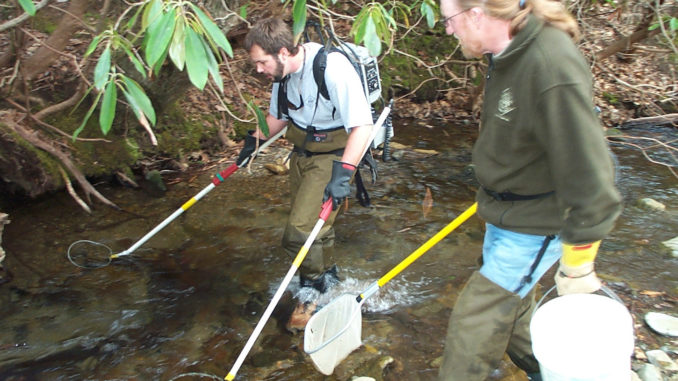
RALEIGH, N.C. – Brook trout once thrived in nearly every coldwater stream and river in the eastern United States, but unfortunately that isn’t so any more. Over the last century, urbanization, poor land management practices and degraded streamside habitat have ravaged brook trout populations, particularly in North Carolina where this native fish has been eliminated or greatly reduced throughout more than 80 percent of its historical habitat.
And North Carolina is not alone. This grim assessment of the brook trout’s status in North Carolina is similar to other states along the East Coast, according to report released last week by the Eastern Brook Trout Joint Venture (EBTJV). The EBTJV, a partnership of state and federal agencies, conservation organizations and academic institutions including Trout Unlimited and the N.C. Wildlife Resources Commission, is dedicated to restoring brook trout to fishable populations by protecting, restoring and enhancing aquatic habitat throughout the brook trout’s range.
The report, “Eastern Brook Trout: Status and Threats,” provides information on the status of brook trout populations in 17 states along the East Coast, an area that represents 70 percent of the historical range of brook trout in the United States. The report also identifies the principal threats to brook trout populations on a state-by-state basis.
In North Carolina and Tennessee, which share many of the same watersheds, a variety of factors led to the brook trout’s decline. Large-scale logging in the 19th century coupled with poor land management associated with agriculture caused massive soil erosion and opened the formerly shaded streams to the sun. As sediment choked the streams and water quality declined, brook trout began to disappear. In their place, rainbow trout, which are native to the Western United States, and brown trout, which are native to Europe, were introduced. These trout species could tolerate warmer and less pristine waters than brook trout. As a result, they often outcompeted brook trout for food and space.
Today, the majority of North Carolina’s brook trout populations are relegated to headwater streams in the Great Smoky Mountains National Park and Pisgah and Nantahala national forests. These publicly owned lands still have some of the highest quality trout habitat remaining in the Southeast.
However, brook trout populations on private lands in North Carolina face a much bleaker future.
“Continued destruction of brook trout habitat from logging, agriculture and development leave many of the remaining populations particularly vulnerable,” said Doug Besler, coldwater research coordinator for the Wildlife Resources Commission. “Brook trout are an excellent indicator of water quality, and their loss in many of our streams should serve as a wake-up call to the citizens of North Carolina.”
Efforts like the EBTJV seek to educate the public and legislators to the plight brook trout face and generate support that will restore and protect brook trout and reverse these negative trends that are occurring throughout their native range.
The EBTJV began in 2004 as a pilot program for the National Fish Habitat Initiative. This report represents the first collaborative effort to identify the status of brook trout habitat across the entire eastern United States. The full report, as well as state-specific data and maps, is available at www.brookie.org.




Be the first to comment